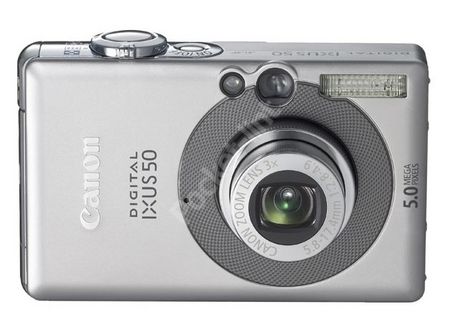Compact and full of gimmicks, but is it enough to impress? We take a look at the Canon Ixus 50, the latest weapon from Canon in the digital compact arena.
Playing about with colours is something most of us do after we have transferred digital pictures from camera to computer. Now you can do it on your camera before you take a picture. Canon's IXUS 50 introduces a new mode called My Colours, though annoyingly, Canon has left the American spelling unchanged for the UK model. It allows you to change the colours in the picture you are about to take. The balance between red, green and blue can be altered, skin can be given pale or tanned effects and one colour can be highlighted with everything else rendered in black and white. Colours can also be swapped.
We put My Colours to the test on a bottle of tomato ketchup. With the camera in shooting mode, clicking the Function/Set button displays 9 different modes - Auto, Manual, Digital Macro, Portrait, Night Snapshot, Kids & Pets, Indoor, Underwater and, lastly the new mode, My Colours. Selecting My Colours opens a sub-menu displayed along the bottom of the LCD screen with nine options. The first option, Positive Film, produces intense natural appearing colours like those obtained with positive film. There are two options for skin colour - Lighter Skin Tone and Darker Skin Tone. These worked well, colouring our lily-white skin with a light Mediterranean tan whilst leaving all the other colours in the shot true. Our favourite options were Colour Accent and Colour Swap. The first lets you transform an image into black and white but keep one colour true. Colour Swap lets you select a colour on the LCD screen and swap it for another one. Controls are very easy to use. It takes seconds to swap red ketchup for white and then yellow and then green and see the results of your creative photography. If you are unsure about the effect you want then original images can be recorded at the same time as the My Colour versions. My Colours also works in Movie Mode.
The IXUS 50 features another first: Canon's QuickBright function on the LCD screen. The 2inch LCD is important because the viewfinder on this camera is grotty and difficult to use for anyone with a nose. Pressing the display button for over a second increases the light behind the LCD screen. Pressing it again restores the original setting. Canon claims that QuickBright improves visiblity in glare or outdoor conditions. This was the case in our tests, but the improvement was so minimal as to make little difference. Sony has a better solution to washed-out LCD screens in our view with its Clear Photo technology. Sony, in our experince, also gives more useful information than Canon on battery power and storage capacity. Canon's low battery indicator appears just before you run out of juice whereas Sony's indicator shows a full battery and then exactly how much power you are using. We set our IXUS 50 to its lowest quality image setting because we were testing it with the tiny 16MB storage card that comes with the camera. The information it gave on how many shots we had left was quite inaccurate. When the indicator said 119, for 119 shots left, we were able to take a further 31 shots before the memory card was full. If you don't want to be caught out, buy a much bigger memory card and a second battery.
Our quick take
Aside from My Colours and QuickBright, the IXUS 50 is almost identical to Canon's IXUS 40, which we reviewed in November 2004. The IXUS 50 adds a megapixel, but this will make no difference to standard, 6 x 4 prints. However at A3 it will give noticeably better quality.
We checked prices on the two models for this review. At around £20.00 more, the IXUS 50 seems good value for such a versatile, high quality compact camera which looks as good today as when Canon launched the first IXUS camera nine years ago. Plus, if you ever want to blow up treasured shots to mini poster size, they'll carry on looking good on the 50.

Canon IXUS 50 digital camera - 4.0 / 5
| FOR | AGAINST |
|---|---|
|
|
To recap
Aside from My Colors and QuickBright, the IXUS 50 is almost identical to Canon's IXUS 40
